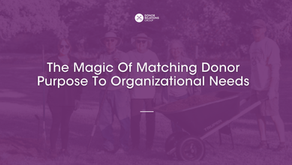Unlock the Ultimate Donor Matrix: A Step-By-Step Guide
- Lynne Wester

- Mar 13, 2024
- 4 min read

Do you have a steady stream of new donors annually, but find yourself having a hard time retaining those donors year after year? You are not alone.
We've all heard the statistic—it costs seven times more to acquire a new donor than to retain a current donor. So, how do we retain donors? What strategies can we implement that will ensure each donor's behavior is not only recognized, but feels their gift is meaningful? How do we retain donors and show them they are making a difference? If you want to retain donors but can’t seem to find the secret sauce—we've got you!
A donor matrix is the best place to begin. Let’s start with unpacking a donor matrix. What is the matrix and how can it play a critical part in your organization’s donor relations efforts? Simply put, a donor matrix is a chart that shows how and when your organization stewards each donor segment.
A donor matrix should be simple, straightforward, action-oriented, and include each of the donor segments you identify as vital to your organization. So, let's dive in and explore how you can develop a matrix that is not only a resource tool for everyone in your organization, but one that guides your donor relations program to success—including higher overall retention.
Communications for your organization should inspire donors to give again. They should be:
Joyful
Fulfilling
Instantly satisfying
Empowering
When developing a donor matrix, going back to these key elements will help drive your plan to produce communications that invoke positive relations with your organization.
Step 1: Make a list of all donor communications.
Let’s start with the basics. A donor matrix should encompass every touchpoint and communication that a donor who gives to your organization receives, and should be broken down by behavior. To begin developing a donor matrix, start with a list of every touchpoint for each donor, regardless of amount. Some examples include:
Tax receipt
Acknowledgment
All additional recognition
Digital communications (general or personalized)
Print communications (general or personalized)
Event invitations
Holiday/seasonal messages
Step 2: Create a list of donor behaviors and identify which behaviors you want to build a plan for.
Next, identify behaviors you notice and recognize from donors at your organization. You may notice other behaviors that you would like to recognize that aren’t included in the list below. When making a list, you don’t necessarily need to have a plan for each donor behavior, we will get to that in a moment, but you will want to identify the donor behaviors that you would like to develop a plan for. The first step is identification, after this, you will be able to build out your donor retention program. A sampling of these behaviors are listed below:
First time donors
Giving day donors
Honor and memory gifts
Pledge payments
Reacquired/lapsed) donors
Increase/double donors
Monthly donors
Project/crowd/funding donors
Loyal donors (giving milestones)
Faculty and staff donors (one-time and payroll deduction)
Named fund donors
Planned giving donors
Matching gift donors
Event attendees
Step 3: Include input from other departments.
The donor matrix should include all activities that reach your donors from across the organization—remember, our goal is for the donor matrix to include ALL donor touchpoints. In brainstorming which teams should provide their communications to the matrix, be sure to include the following groups:
Donor Relations
Annual Giving
Events
Communications
Advancement Services
Development Officers
Any other team that regularly communicates with donors
Step 4: Start building your matrix.
After compiling the communications, events, and general touchpoints you have for each donor behavior, (you may be surprised at how many, or lack of, touches donors already receive) you are ready to build out your donor matrix.
There are several formats you can use when developing your donor matrix, so it's important to find the layout and structure that works best for your organization. This is a fluid document, and it should be created with the knowledge that it will continually be evolving.
Below are examples of donor matrices that are inclusive, easy to follow, and encompass each area of donor behavior.


Step 5: Put your matrix to use!
Once you have your donor matrix created, it’s time to put it to use. We recommend tackling 1-2 donor behaviors that you would like to build out in your donor matrix each year. It could be first-time donors and planned giving donors, or perhaps you would like to focus on reactivated donors. Utilize your data to drive the decision on which donor behavior to focus on, and then, you can begin building out your plan and donor touchpoints.
After building out the communications, deliverables, and timelines for these donor segments, add it all to your donor matrix. As you continue to add to your plan, any gaps and opportunities in your donor relations program will start to appear, and this will guide your future efforts to increase retention.
Speaking of retention rates, don't forget to provide metrics around your donor relations efforts. Sample metrics you can assign to your donor matrix include:
First time donor retention year-over-year
Overall retention year-over-year
Additional gifts within one year
Quantity of donor touchpoints/tiered
Communication stats (open, click through, download, response, etc.)
The donor matrix is a powerful resource for guiding your donor relations program. When implemented correctly and referenced by all members of your organization, it will help your team recognize behaviors and giving triggers. Additionally, the donor matrix keeps you from the common pitfall of mainstreaming donors. It gives you a multi-touch, multi-channel approach to donor communications and provides a clear overview of your program.
If you would like additional assistance developing a donor matrix for your organization, DRG is here to help. Contact info@donorrelations.com for more information on how DRG can help you create a custom donor matrix!
By Holly Kizer





